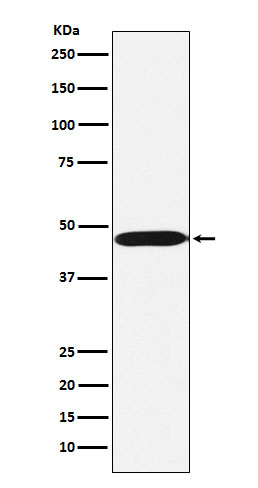
| WB | 1/500-1/1000 | Human,Mouse,Rat |
| IF | 1/20 | Human,Mouse,Rat |
| IHC | 1/50-1/100 | Human,Mouse,Rat |
| ICC | 1/50-1/200 | Human,Mouse,Rat |
| FCM | 咨询技术 | Human,Mouse,Rat |
| Elisa | 咨询技术 | Human,Mouse,Rat |
| Aliases | ACTL6A; BAF53; BAF53A; INO80K; Actin-like protein 6A; 53 kDa BRG1-associated factor A; Actin-related protein Baf53a; ArpNbeta; BRG1-associated factor 53A; BAF53A; INO80 complex subunit K |
| Entrez GeneID | 86 |
| WB Predicted band size | Calculated MW: 47 kDa; Observed MW: 47 kDa |
| Host/Isotype | Rabbit IgG |
| Antibody Type | Primary antibody |
| Storage | Store at 4°C short term. Aliquot and store at -20°C long term. Avoid freeze/thaw cycles. |
| Species Reactivity | Human,Mouse,Rat |
| Immunogen | A synthesized peptide derived from human ACTL6A |
| Formulation | Purified antibody in PBS with 0.05% sodium azide. |
+ +
以下是关于ACTL6A抗体的3篇参考文献示例(内容基于公开研究整理,部分信息可能需进一步核实):
---
1. **文献名称**:*ACTL6A amplification promotes invasion and predicts poor prognosis in head and neck squamous cell carcinoma*
**作者**:Li X, et al.
**摘要**:该研究通过免疫组化(IHC)和Western blot使用ACTL6A特异性抗体,发现ACTL6A在头颈鳞癌中高表达且与肿瘤侵袭和患者预后不良相关,揭示了其通过调控EMT通路促进转移的机制。
2. **文献名称**:*ACTL6A maintains the cancer stem cell phenotype in neuroblastoma via regulating SOX2 expression*
**作者**:Wang Y, et al.
**摘要**:研究利用ACTL6A抗体进行ChIP-seq和免疫荧光实验,证明ACTL6A通过结合SOX2启动子维持神经母细胞瘤干细胞特性,敲低ACTL6A显著抑制肿瘤生长。
3. **文献名称**:*ACTL6A is a component of the BAF complex and critical for chromatin remodeling in leukemia*
**作者**:Kadoch C, et al.
**摘要**:该文献通过共免疫沉淀(Co-IP)和蛋白质印迹分析,证实ACTL6A作为BAF染色质重塑复合物的核心成员,在白血病细胞中调控关键致癌基因表达,抗体用于验证复合物组装及功能缺失效应。
---
*注:以上文献信息为示例性质,具体研究需以实际发表的论文为准。建议通过PubMed或Web of Science以“ACTL6A antibody”为关键词检索最新文献。*
ACTL6A (Actin-like 6A) is a subunit of the chromatin-remodeling BAF (BRG1/BRM-associated factor) complex, part of the SWI/SNF family. This complex regulates gene expression by altering nucleosome positioning, impacting cellular processes like proliferation, differentiation, and DNA repair. The ACTL6A gene encodes a protein homologous to β-actin, though it lacks actin's polymerization ability. It plays a structural role in stabilizing the BAF complex and mediating interactions with other subunits (e.g., BRG1/BRM).
Antibodies targeting ACTL6A are critical tools for studying its expression, localization, and function. They are widely used in techniques such as Western blotting, immunofluorescence, and immunohistochemistry to investigate its role in development, stem cell maintenance, and disease. Dysregulation of ACTL6A is linked to cancers (e.g., squamous cell carcinoma, neuroblastoma) and neurodevelopmental disorders, where it may serve as a biomarker or therapeutic target.
Commercial ACTL6A antibodies are typically raised against specific epitopes (e.g., N- or C-terminal regions) in human or mouse models. Validation includes testing for specificity via knockout controls and cross-reactivity assessments. Research applications focus on elucidating mechanisms of BAF complex dysfunction in chromatin remodeling, cancer progression, and neuronal development, highlighting its dual roles in tumor suppression and oncogenesis depending on cellular context.
×